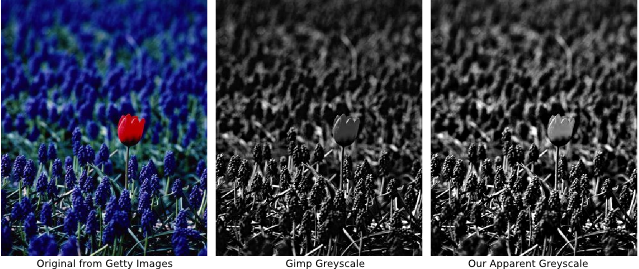


The basic problem of greyscale transformation is to reproduce the intent of the colour original, its contrasts and salient features, while preserving the perceived magnitude and direction of its gradients. The transformation consists of two interdependent tasks: a mapping that assigns a grey value to each pixel or colour, and a discriminability constraint so that the achromatic differences match their corresponding original colour differences. Recent approaches solve discriminability constraints to determine the grey values, producing images in which the original colour contrasts are highly discriminable. However, the greyscale images may exhibit exaggerated dynamic range, an arbitrary achromatic order that differs among colour palettes, and a smoothing or masking of details. These modifications all contribute to make the grey version appear dissimilar from its original and create inconsistency among like images and video frames.
The goal of this work is to create a perceptually accurate version of the colour image that represents its psychophysical effect on a viewer. Such greyscale imagery is important for printed textbooks and catalogues, the stylization of videos and for display on monochromatic medical displays. A perceptually accurate image is one that emulates both global and local impressions: it matches the original values' range and average luminance, its local contrasts are neither exaggerated nor understated, its grey values are ordered according to colour appearance and differences in spatial details are imperceptible. Strong perceptual similarity is particularly important for consistency over varying palettes and temporal coherence for animations.
In a perceptual study of greyscale conversion algorithms by Martin Čadík, Apparent Greyscale was shown to produce the most perceptually accurate results and have the most consistent performance on all test images. Resulting greyscale images were also rated very highly in user preference. Published in Pacific Graphics, 2008, Perceptual Evaluation of Color-to-Grayscale Image Conversions.
Two bugs fixed in the Gimp plug-in.
This paper presents a quick and simple method for converting complex images and video to perceptually accurate greyscale versions. We use a two-step approach first to globally assign grey values and determine colour ordering, then second, to locally enhance the greyscale to reproduce the original contrast. Our global mapping is image independent and incorporates the Helmholtz-Kohlrausch colour appearance effect for predicting differences between isoluminant colours. Our multiscale local contrast enhancement reintroduces lost discontinuities only in regions that insufficiently represent original chromatic contrast. All operations are restricted so that they preserve the overall image appearance, lightness range and differences, colour ordering, and spatial details, resulting in perceptually accurate achromatic reproductions of the colour original.


